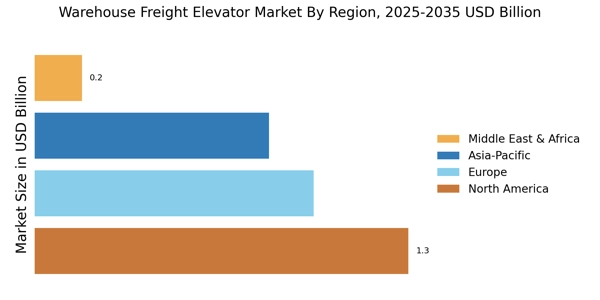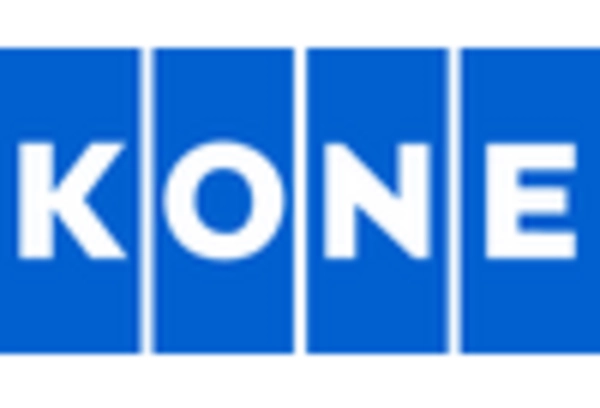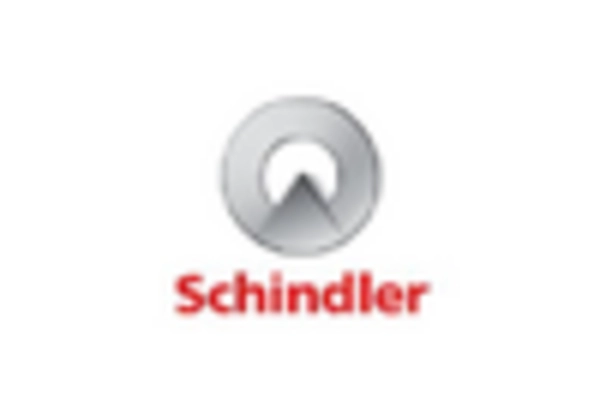Rising E-commerce Demand
The surge in e-commerce activities has led to an increased need for efficient logistics and warehousing solutions. As online shopping continues to expand, warehouses are required to optimize their operations, which includes the installation of advanced Warehouse Freight Elevator Market systems. This demand is driven by the necessity to transport goods swiftly and safely within large storage facilities. According to recent data, the e-commerce sector is projected to grow at a compound annual growth rate of over 15%, further propelling the Warehouse Freight Elevator Market. The need for rapid order fulfillment and inventory management is likely to necessitate the integration of more freight elevators in warehouses, thereby enhancing operational efficiency.
Increased Focus on Safety Regulations
Safety regulations are becoming increasingly stringent in the Warehouse Freight Elevator Market, prompting warehouse operators to invest in compliant elevator systems. Regulatory bodies are enforcing standards that ensure the safe operation of freight elevators, which includes regular inspections and maintenance protocols. This focus on safety is likely to drive the demand for advanced elevator systems that meet or exceed these regulations. As warehouses strive to create safer working environments, the need for reliable and compliant freight elevators will grow. Consequently, manufacturers are expected to innovate and enhance their offerings to align with these safety standards, further influencing the Warehouse Freight Elevator Market.
Urbanization and Infrastructure Development
Urbanization trends are contributing significantly to the Warehouse Freight Elevator Market. As populations in urban areas continue to grow, the demand for efficient storage and transportation solutions within high-rise buildings and warehouses increases. Infrastructure development projects, including new commercial and residential buildings, often require the installation of freight elevators to facilitate the movement of goods. This trend is supported by government initiatives aimed at improving urban infrastructure, which may lead to an increase in construction activities. The Warehouse Freight Elevator Market is expected to benefit from these developments, as more facilities will require advanced elevator systems to meet the logistical challenges posed by urban environments.
Technological Advancements in Elevator Systems
Technological innovations are transforming the Warehouse Freight Elevator Market, making freight elevators more efficient and reliable. The integration of smart technologies, such as IoT and AI, allows for real-time monitoring and predictive maintenance, which can reduce downtime and enhance operational efficiency. Furthermore, advancements in energy-efficient designs are appealing to warehouse operators looking to minimize operational costs. The market is witnessing a shift towards automated systems that can optimize load management and improve safety standards. As these technologies become more prevalent, they are likely to drive the demand for modern freight elevators in warehouses, thereby expanding the Warehouse Freight Elevator Market.
Growth of the Logistics and Supply Chain Sector
The logistics and supply chain sector is experiencing robust growth, which is positively impacting the Warehouse Freight Elevator Market. As companies seek to streamline their supply chain operations, the demand for efficient warehousing solutions, including freight elevators, is on the rise. The increasing complexity of supply chains, driven by globalization and consumer expectations for faster delivery, necessitates the use of advanced material handling equipment. Market data indicates that the logistics sector is projected to expand significantly, which will likely lead to increased investments in warehouse infrastructure. This trend suggests a promising outlook for the Warehouse Freight Elevator Market, as more facilities will require sophisticated elevator systems to enhance their operational capabilities.


















Leave a Comment